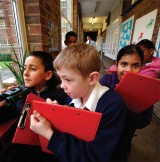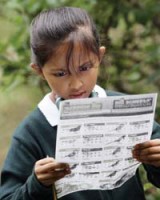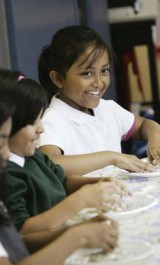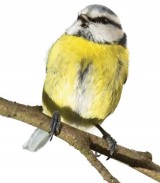Feather your nest with these practical and cross curricular activities from the RSPB’s Caroline Offord...
Wild birds are an unbeatable teaching resource. Active, colourful and abundant they never fail to enthuse children encouraged to observe their quirky behaviour at first hand. Teachers who take time to study the bird life in their school grounds will soon be bombarded with questions that will drive their lessons forward. And from this starting point, you’ll find it’s easy to cultivate children’s interest in nature and conservation. If exploring the world of wild birds doesn’t already feature in your planning, there’s no better time to get started than during RSPB’s Big Schools’ Birdwatch (18 January – 1 February 2010). Not only does it provide children with a genuine purpose for their observations, it can be the springboard for a complete topic. Take a look at these ideas and see if they get your creative gears whirring.
 (Design & Technology/Art/Science/Citizenship)
(Design & Technology/Art/Science/Citizenship)
The first step towards using birds as a teaching resource is to attract them to an area of your school where they can be easily seen. And perhaps the best way of doing this is to make sure a free meal is always on offer.
Putting out a wide selection of foods will attract different species of birds, and children can begin this activity by discussing and researching their various eating habits.
Once they’ve done this, challenge the children to design menus for the birds visiting their school. For example, starlings eat fruit, seeds and berries, while robins mainly eat insects but also like cheese. This can be reinforced with a practical task – making seed cakes for birds.
One recipe idea is to make edible pictures. Ask the children to draw a picture on a piece of wood. Paint over the pencil lines with soft lard or vegetable fat. Place bird seed over the lard and shake off the excess to complete your seed picture. Ask the children to hang their picture outside and watch the birds eat their artwork.
Involve the class by creating a feeding station outside the classroom window. Put different sorts of food in different feeders. Record which birds prefer which food, how long different birds spend feeding and whether they feed alone or in a group? Spot how different species are adapted to help them eat certain foods.
You could also run a special ‘Bird Breakfast Day’ where the children can eat fresh and dried fruits, seed and perhaps cheese; all the things birds are partial to.
 (Design & Technology/Literacy)
(Design & Technology/Literacy)
To help them record which birds visit the school, children can build a hide. Having chosen a suitable spot in the classroom, they should stick sheets of black sugar paper over the window, covering an area from the floor to just above head height. Narrow slots (3-4cms wide) should be left at sitting or standing eye levels. Now, with hushed silence and noses pressed up against the window, children can watch without disturbing the birds.
Pupils should keep a record of how many birds they see and note down the different species (this data will be useful for maths activities, such as the ‘living bar graph’, see right). You could also encourage children to draw the birds and put their pictures up in the hide.
For an extra bit of fun, why not hide images of different birds around the school grounds and ask children to find them? They could be given nature-based clues to point them in the right direction.
(Maths)
This is a great way for children to explore and interpret real data.
Having watched birds visiting your school grounds for a set period of time, or perhaps after taking part in the RSPB’s Big Schools’ Birdwatch, collate the children’s findings into one set of class results.
Now find a large, clear floor space in the classroom or outside. Using masking tape, mark out a giant bar graph and, along one axis, designate a section for each species of bird the children have recorded seeing.
 Put the combined class data on display and ask the children to represent this by lining up in the correct spaces on the bar graph – each child representing one bird.
Put the combined class data on display and ask the children to represent this by lining up in the correct spaces on the bar graph – each child representing one bird.
By examining their living graph, encourage the children to answer questions such as: where is the shortest line? What does this mean? Which bird was seen the most or least? How many more starlings were seen than robins?
You could also ask the children to dress up in different colours (blue for blue tit, red for robin etc.) or make masks to represent the various birds shown on the graph.
 (Science/Design & Technology)
(Science/Design & Technology)
For this activity, you will need a range of different materials. You could send a letter home encouraging children to bring in appropriate resources - twigs, hay, grass, leaves - or you could go out and gather materials as a class activity beforehand.
Look at pictures of nest boxes and nests. Discuss how and why birds build nests and what materials they use. Children should then attempt to construct their own nests with the materials they have collected, using paper bowls/plates as a base.
While they are doing this, hold a discussion about how birds go about building their nests in the wild. Encourage children to think about the materials they select to make the nests – rigid around the outside and soft inside.
 Take part in something special
Take part in something special
Running from 18 January – 1 February 2010, the RSPB’s Big Schools’ Birdwatch is a fun activity to educate and inspire children about the wildlife that shares their school environment. It is suitable for children of all ages and appeals to teachers because it’s fun, easy and simple to set up.
All you have to do is count the birds in your school for a total of one hour and send in your results to the RSPB. Not only will you be taking part in the world’s biggest birdwatch, the information you provide will help the RSPB monitor UK bird numbers.
For more information and to register for your free Big Schools’ Birdwatch pack, visit http://www.rspb.org.uk/schoolswatch or call the RSPB hotline number 0300 456 8340.
The pack contains everything you’ll need to plan a fantastic birdwatch, including a simple photocopiable counting chart and colour identification poster.
For further information about the RSPB’s work in schools, further activity ideas and downloadable teaching resources, visit the RSPB website: http://www.rspb.org.uk/ourwork/teaching
How children react to a moral dilemma may be down to your teaching
Ace-Classroom-Support
8 Ways To Get Your Class Drawing
Ace-Art-And-Design
